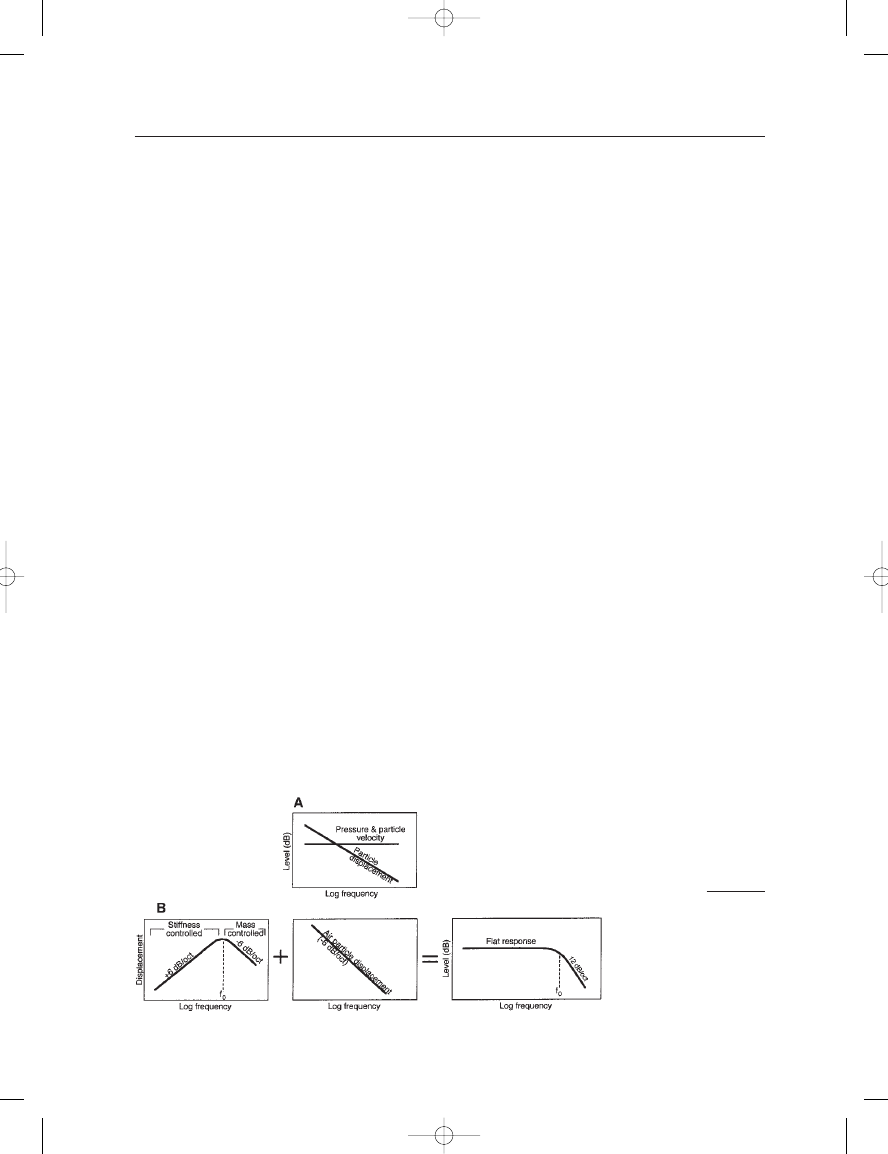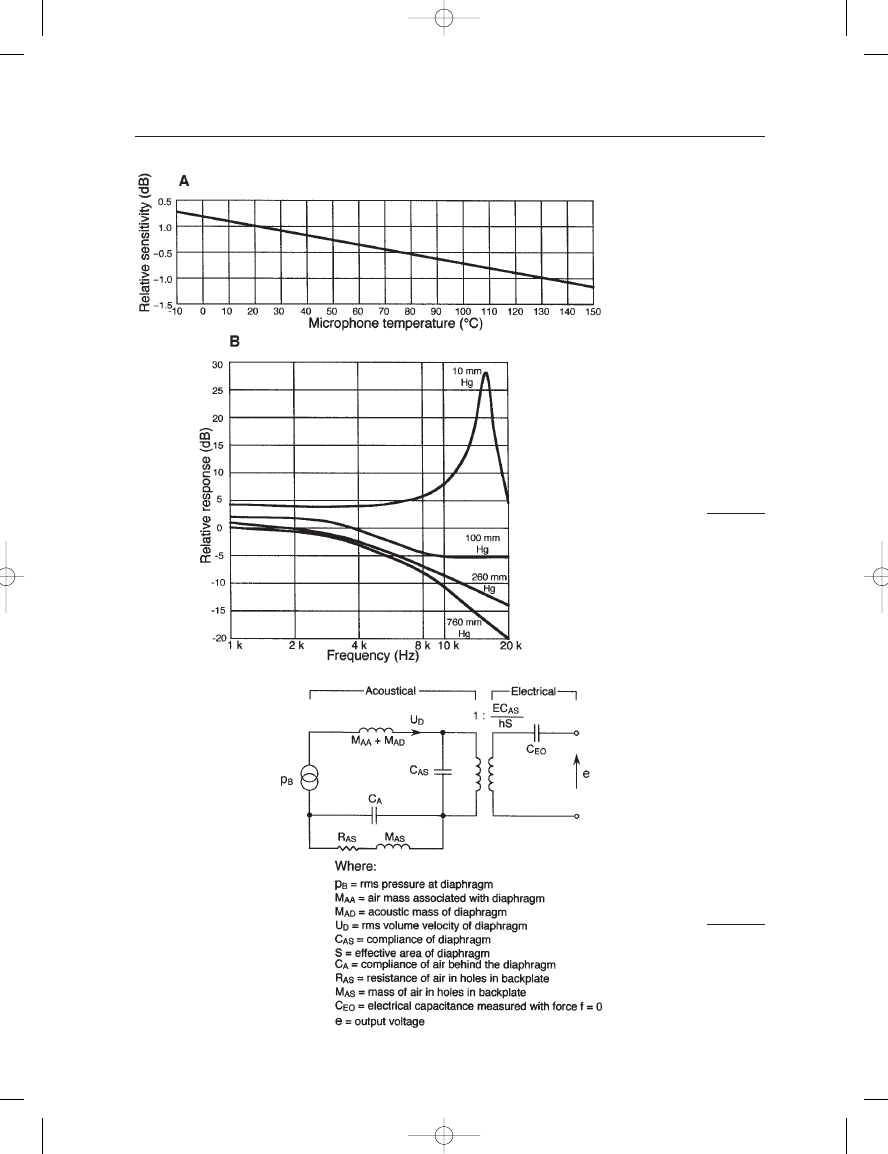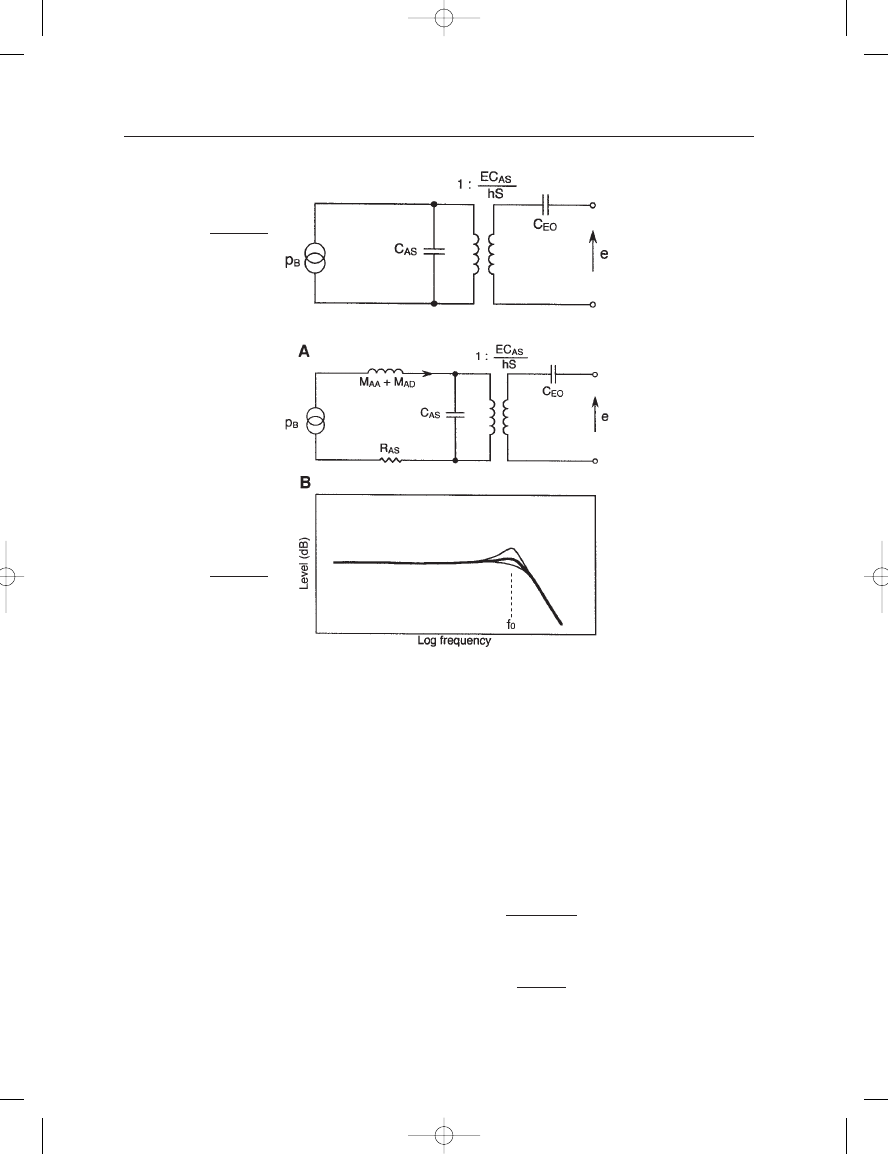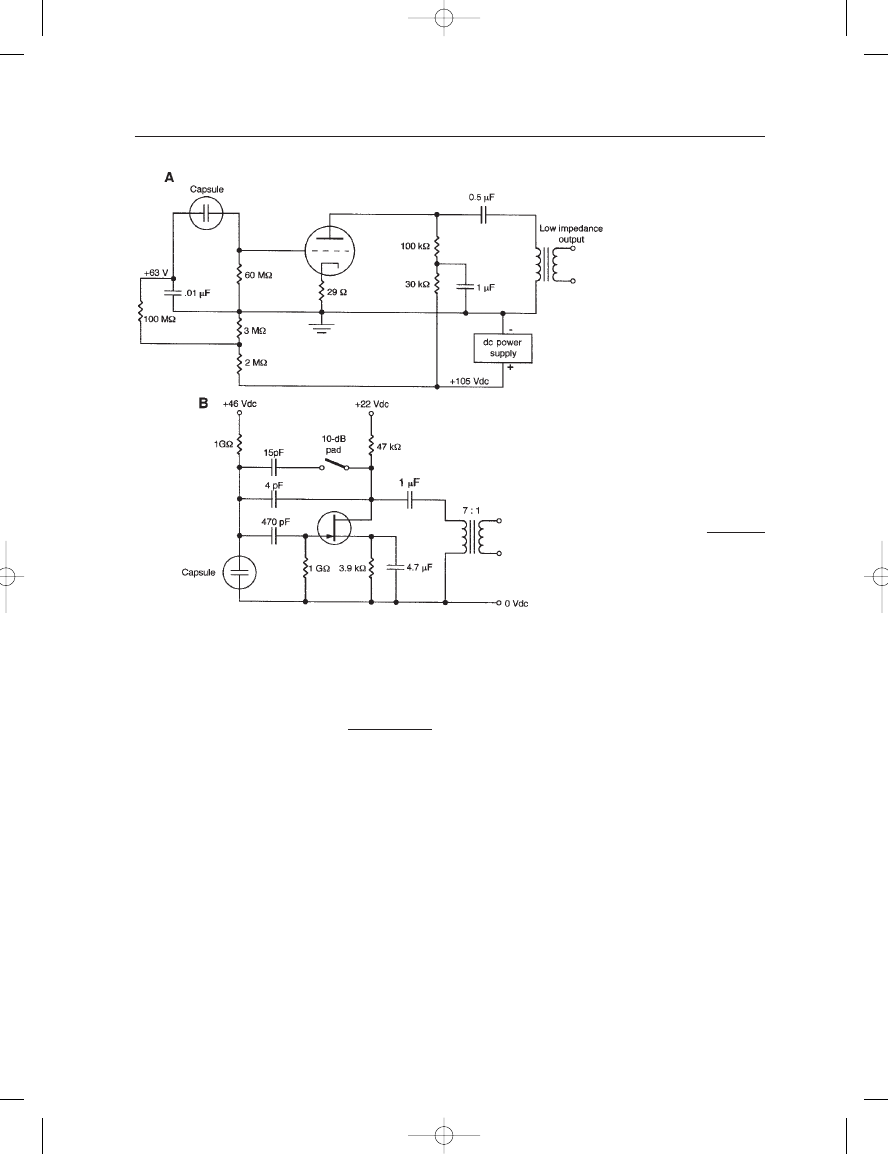ВУЗ: Казахская Национальная Академия Искусств им. Т. Жургенова
Категория: Книга
Дисциплина: Не указана
Добавлен: 03.02.2019
Просмотров: 17243
Скачиваний: 51

The response is further modified by the
j complex operator, which
shifts the relative phase by
90.
Remember that the diaphragm is under considerable mechanical ten-
sion, with additional stiffness provided by the small air chamber behind
it. When a pressure wave impinges on the diaphragm, it encounters a
mechanical responsiveness proportional to j
/S, where S is the mecha-
nical stiffness of the diaphragm (N/m). The j
/S term describes a response
directly proportional to frequency (i.e., rises 6 dB per octave with increas-
ing frequency). The response is further modified by the positive j complex
operator, which shifts the relative phase by 90
. We see the two effects are
complementary and their combined effect is shown as:
(3.4)
where e
j
t
/S now is of the same form as u(t).
Therefore, the response is flat and the net phase shift is 0
in the
range over which the diaphragm is stiffness controlled.
The entire process is shown graphically in Figure 3–5. At A, the free
field relationships among air particle velocity, pressure, and displacement
are shown. At B, the combination of air particle displacement and
diaphragm resonance is shown.
Between the ranges of diaphragm stiffness and mass control is the
region of resonance; and for most studio microphones, this ranges from
about 8–12 kHz. In most microphones, the resonance is fairly well
damped so as not to cause an appreciable rise in response; perhaps no
more than about 2 or 3 dB. Beyond resonance, the overall response of the
microphone begins to roll off at a rate of 12 dB per octave; however, the
on-axis response of the microphone tends to remain fairly flat over about
half an octave above resonance, due to diffraction effects similar to those
shown in Figure 2–14.
The output of the capacitor pressure microphone remains very flat
down to the lower frequencies, limited only by the movement of air
through the atmosphere pressure adjusting effect of the capillary tube
and the variations in charge on the capacitor plates through the very high
(
j/)e
j
t
(j
/S)
e
j
t
/S
THE MICROPHONE BOOK
28
FIGURE 3–5
Forces on the diaphragm:
relations among pressure,
air particle velocity, and
air particle displacement
(A); response of a
stiffness-controlled
diaphragm (B).
Earg_03.qxd 14/9/04 2:37 PM Page 28

biasing resistor (see Figure 3–1). In most studio-quality capacitor pres-
sure microphones, LF rolloff effects are usually seen only in the range of
10 Hz or lower.
CAPACITOR MICROPHONE SENSITIVITY TO TEMPERATURE
AND BAROMETRIC PRESSURE
For normal recording, broadcasting, and sound reinforcement applica-
tions using capacitor microphones, changes in response due to tempera-
ture and barometric pressure variations generally may be ignored.
However, in many instrumentation applications, the variations may be
significant enough to warrant recalibration of the measurement system.
The primary effect of temperature increase is a reduction of
diaphragm tension, which causes an increase in sensitivity and a decrease
in bandwidth. The net effect on sensitivity is quite small, roughly of the
order of
0.005 dB/C. (See equations (3.7) and (3.8).)
A decrease in barometric pressure has a slight effect on the LF and
MF (medium frequency) sensitivity of the microphone, but the decrease
in air pressure at the diaphragm at f
0
produces less damping of the
diaphragm motion at resonance, causing an increase in the response at f
0
.
The effects of both temperature and atmospheric pressure variations
on the response of an instrumentation microphone are shown in
Figures 3–6A and 3–6B, respectively.
EQUIVALENT ELECTRICAL CIRCUITS FOR THE CAPACITOR
PRESSURE MICROPHONE
Although the capacitor pressure microphone is of relatively simple con-
struction, it consists of many individual acoustical masses, compliances,
and resistances. Figure 3–7 shows a complete circuit with definitions of
all elements. The transformer represents the conversion from the acousti-
cal domain into the electrical domain.
At LF and MF the circuit can be simplified as shown in Figure 3–8.
At HF, the circuit can be simplified as shown in Figure 3–9A, and the
response curves in Figure 3–9B show the effect of varying the damping
on the diaphragm by altering the value of R
AS
.
DETAILS OF THE PREAMPLIFIER AND
POLARIZING CIRCUITRY
Figure 3–10A shows details of the microphone preamplifier and polariz-
ing system for a vacuum tube design. Much of the complexity here is
determined by the external powering source for polarization and the
necessity for correct dc biasing of the vacuum tube.
Figure 3–10B shows a similar arrangement for a modern FET (field-
effect transistor) solid-stage design. Note here the presence of a 10 dB
attenuating (padding) capacitor around the capsule; the switchable
capacitor shunts the signal generated by the capsule so that the system
3: The Pressure Microphone
29
Earg_03.qxd 14/9/04 2:37 PM Page 29

THE MICROPHONE BOOK
30
FIGURE 3–7
Equivalent electroacoustical
circuit for a capacitor
pressure microphone
(impedance analogy).
(Data after Beranek,
1954.)
FIGURE 3–6
Effects of temperature
variations on the sensitivity
of a capacitor pressure
microphone (A); effect of
atmospheric pressure
variations on the response
of a capacitor pressure
microphone (B). (Data after
Brüel and Kjaer, 1977.)
Earg_03.qxd 14/9/04 2:37 PM Page 30

can operate at higher sound levels without causing electrical overload in
the following preamplification stage.
The shunt capacitor is normally chosen to have a value of about 0.4
that of the capsule itself. The parallel combination of the two capacitors
then has a value of about one-third that of the capsule itself, resulting in
an attenuation of output of about 10 dB. The action of the shunt capaci-
tor is not like that of a simple voltage divider; rather, a slight signal non-
linearity is caused by the circuit.
Let x represent a variable corresponding to the normal signal inci-
dent on the capsule. Then xC represents the varying value of capsule
capacitance without the shunt. The parallel combination of the capsule
and the shunt has a net capacitance equal to
which is of the form
(3.5)
where A
0.4C
2
, B
0.4C, and C is the capacitance of the capsule.
C
net
Ax
B
Cx
C
net
x
0.4C
2
0.4C
Cx
3: The Pressure Microphone
31
FIGURE 3–8
LF and MF response,
simplified equivalent
circuit. (Data after
Beranek, 1954.)
FIGURE 3–9
HF response, simplified
equivalent circuit (A);
response (B). (Data at A
after Beranek, 1954.)
Earg_03.qxd 14/9/04 2:37 PM Page 31

Equation 3.5 can be expanded to
(3.6)
In this form, we see that the simple relationship Cx, which represents the
variable capacitance of the unattenuated capsule, has been transformed
into a combination that includes squared terms in both numerator and
denominator, indicating the presence of second harmonic distortion.
The effect of this is small, considering the minute signal variations
represented by x. In any event, the distortion introduced by the shunt
capacitance is negligible under the high sound pressure operating cir-
cumstances that would normally call for its use.
Signal output at the capsule can also be attenuated by dropping the
dc bias voltage padding in this manner. The Neumann models TLM170
and TLM50 achieve their capsule padding in this manner. The TLM50
is padded by changing the value of dc bias voltage on the capsule from
60 to 23 V. This causes a slight alteration in the microphone’s HF
response due to the reduced electrostatic attraction between diaphragm
C
net
ABx
ACx
2
B
2
(Cx)
2
THE MICROPHONE BOOK
32
FIGURE 3–10
Details of capacitor
microphone preamplifiers:
vacuum tube type (A);
solid-state type (B).
Earg_03.qxd 14/9/04 2:37 PM Page 32